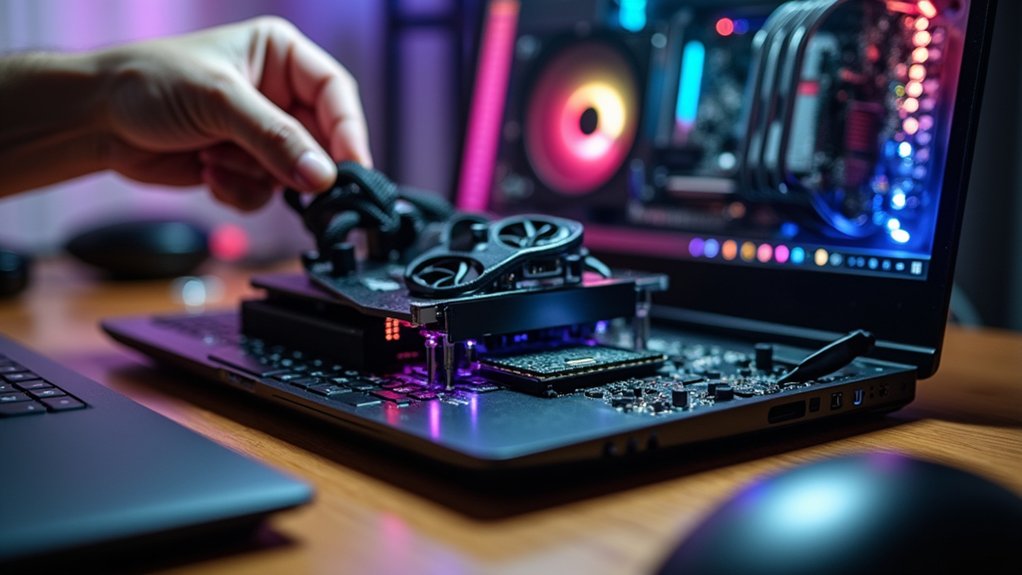
Best video cards and PC specs for 4K gaming
Keen to unlock true 4K gaming performance? Discover which video cards and PC specs deliver stunning visuals—your ultimate setup awaits just ahead.

Thinking about enhancing your gaming laptop‘s performance? Upgrading the graphics card in your gaming laptop might be an attractive option. However, it’s not as straightforward as swapping out components in a desktop PC. Gaming laptops often present unique challenges and hidden limitations when it comes to a graphics card upgrade. Before you grab a screwdriver or start browsing for a new GPU, it’s essential to understand what’s truly feasible. Knowing what steps to take next is crucial for a successful graphics card upgrade in a gaming laptop.

Upgrading a laptop GPU can be quite challenging compared to swapping out a desktop graphics card. Most gaming laptops come with soldered GPUs, making the upgrade process nearly impossible without the right tools. This makes laptop GPU upgrades a hot topic in tech circles.
Additionally, hurdles like power delivery, thermal management, and limited internal space add to the complexity. Laptop manufacturers often design these devices with specific components, which means that upgrading isn’t as simple as it’s with desktops.
If you’re diving into laptop GPU upgrades, ensure you’re aware of the unique challenges involved.
Are you thinking about upgrading your gaming laptop’s graphics card? Before you dive in, it’s crucial to check your laptop’s GPU compatibility.
Most gaming laptops come with integrated or soldered GPUs, making them non-replaceable. However, a select few models do offer modular graphics cards, especially those with MXM slots.
To determine if your laptop supports a GPU upgrade, visit the manufacturer’s website or review your device’s documentation. Remember, without a compatible GPU slot, swapping out the graphics card simply won’t be possible.
Checking your laptop’s GPU compatibility ahead of time can save you both time and effort.
If you’re looking to upgrade your laptop’s GPU, the first step is to check the current GPU model and its specifications.
To do this, open Device Manager and locate the “Display adapters” section to identify your GPU model. For more detailed information, use tools like GPU-Z or Speccy to discover your GPU’s VRAM size, architecture, and other critical specifications.
Make sure to record this GPU information for future reference, as it will be essential for a successful upgrade.
Looking to upgrade your gaming laptop’s graphics card? Start by researching your laptop model online to determine if it supports GPU upgrades.
Dive into manufacturer documentation, user forums, and compatibility lists for detailed insights. If your gaming laptop uses MXM modules, focus on these, as most gaming laptops come with soldered GPUs that aren’t easily replaceable.
Always double-check compatibility before making any purchase to avoid costly mistakes. Finding the right graphics card upgrade can enhance your gaming experience, so take the time to ensure the upgrade fits your laptop model perfectly.
Gathering the necessary tools and materials for your laptop GPU upgrade ensures a smooth and efficient process.
Before you start, make sure you’ve confirmed your laptop supports a GPU upgrade and identified a compatible graphics card.
To get started, you’ll need a few essential items: a precision screwdriver set, an anti-static wrist strap, thermal paste, cleaning wipes, and a small container for screws.
Keep your new graphics card and the laptop’s manual within reach.
Having all these tools and materials ready will prevent unnecessary delays and help you work efficiently during the laptop GPU upgrade.
Before diving into laptop disassembly, it’s vital to back up your data securely. Ensure all your essential files are saved to an external drive or cloud storage, protecting you from unexpected data loss.
When preparing your workspace, choose a clean and clutter-free environment to keep your laptop components organized. Using an anti-static mat is recommended to prevent static electricity damage, and wearing an anti-static wrist strap adds an extra layer of protection for sensitive tech components.
Disassembling your gaming laptop safely can seem daunting, but with a step-by-step approach, it becomes quite manageable.
To start, ensure your laptop is powered down and unplugged from any cables to prevent any electrical issues. If possible, remove the battery to further secure your device.
Using a precision screwdriver, carefully unscrew the back panel, making sure to keep track of each screw to avoid any mix-ups when reassembling.
Take your time as you gently pry open the case using a plastic tool; this will help prevent any potential damage.
Remember to ground yourself to avoid any static discharge, which can harm your gaming laptop’s sensitive components.
As you dive into the world of upgrading your laptop, the next step is replacing or installing the new graphics card.
First, locate the existing graphics card in your laptop. Carefully disconnect any attached cables or screws securing the graphics card in place. Remember, it’s important to handle these components gently to avoid damage.
Once the old graphics card is removed, align the new graphics card with the slot. Insert it firmly but gently, making sure it sits perfectly in place. Secure it with screws and reconnect any cables you previously removed.
Double-check that everything is snug and securely fitted before moving on. By following these steps, you’re ensuring a seamless process of graphics card replacement, enhancing your laptop’s performance and capabilities.
Once you’ve installed the new graphics card in your laptop, it’s essential to reassemble it with care to ensure everything functions smoothly.
Start by carefully reconnecting all cables and making sure each connection is secure. Next, reattach the case panel and tighten every screw to prevent any components from being loose. Double-check that nothing is misplaced, as the proper assembly is crucial for optimal performance.
After reassembly, power on your laptop to check for normal boot behavior. Pay close attention to any error messages, display issues, or unusual noises that may suggest a problem with the graphics card or any other component.
After reassembling your laptop, it’s essential to update your graphics drivers to ensure your new hardware performs optimally.
Head to the official website of your graphics card manufacturer, download the latest graphics drivers, and install them.
Once your graphics drivers are up-to-date, consider using optimization tools to fine-tune in-game settings, manage power plans, and keep an eye on temperatures.
This approach not only guarantees stable performance but also prevents overheating and enables you to fully harness the power of your upgraded graphics card.
Upgrading your gaming laptop graphics card can be a game-changer, but it’s not as straightforward as upgrading a desktop GPU. Yet, with the right preparation, enhancing your gaming laptop’s graphics card is achievable for certain models. By checking compatibility, gathering necessary tools, and closely following each step, you can significantly increase your chances of a successful upgrade. Always remember to back up your data, take your time, and seek advice from forums or manufacturer guides when needed. By focusing on patience and attention to detail, you’ll soon enjoy improved gaming performance thanks to your upgraded graphics card.

Keen to unlock true 4K gaming performance? Discover which video cards and PC specs deliver stunning visuals—your ultimate setup awaits just ahead.

Before buying a new video card, discover the crucial steps to ensure compatibility with your motherboard—one mistake could cost you.

Curious why gaming graphics cards cost so much? Complex tech and market twists mean there’s more behind the price than you might think.

Considering a hardware upgrade? Check out which PC brands make swapping components a breeze—and discover the standout choice you might not expect.

Discover the top three warning signs your computer may be infected with malware, and see if your device is secretly at risk.

Why does hardware form the backbone of every computer system, impacting everything from speed to security? Discover what makes it truly indispensable.